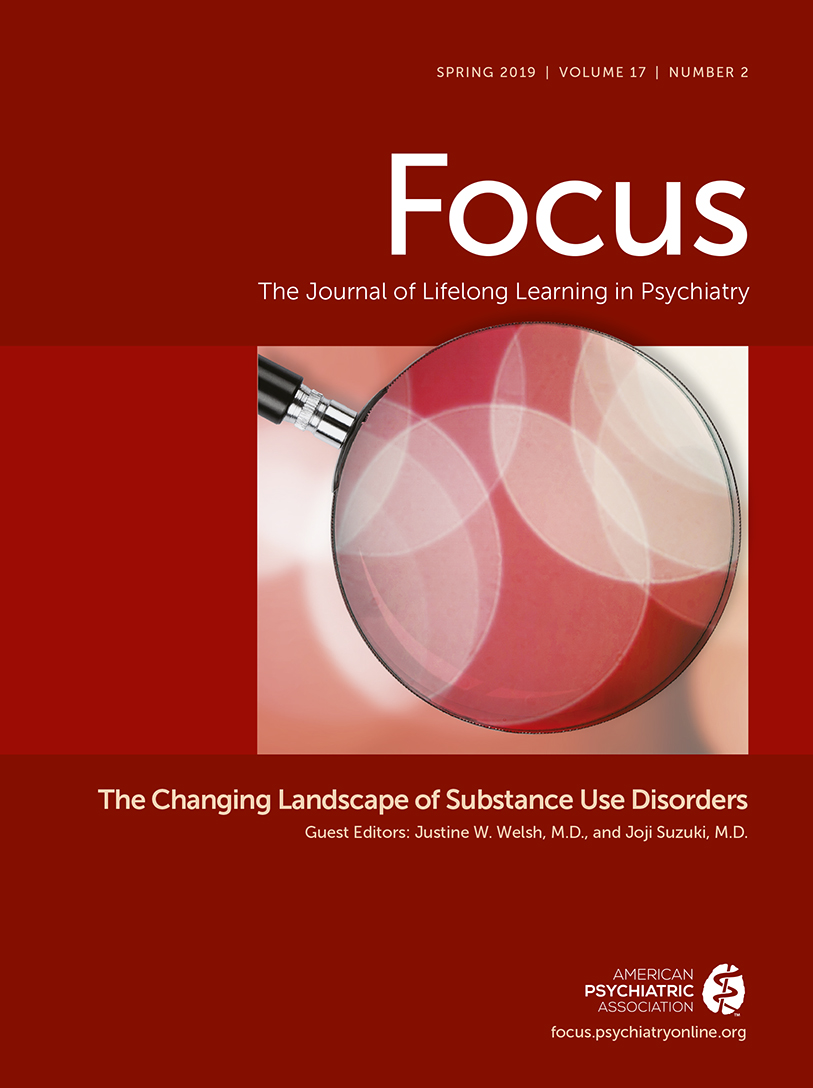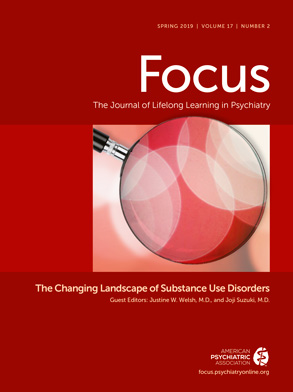Introduction
The goal of this guideline
1 is to improve the quality of care and treatment outcomes for patients with alcohol use disorder (AUD), as defined by DSM-5 (
American Psychiatric Association, 2013). The guideline focuses specifically on evidence-based pharmacological treatments for AUD but also includes statements related to assessment and treatment planning that are an integral part of using pharmacotherapy to treat AUD. AUD pharmacotherapy is a topic of increasing interest given the availability of several medications approved by the U.S. Food and Drug Administration (FDA) for this disorder and the burden of AUD in the population.
Worldwide, the estimated 12-month adult prevalence of AUD is 8.5%, with an estimated lifetime prevalence of 20% (
Slade et al., 2016). In the United States (U.S.), AUD has estimated values for 12-month and lifetime prevalence of 13.9% and 29.1%, respectively, with approximately half of individuals with lifetime AUD having a severe disorder (
Grant et al., 2015). AUD places a significant strain on both the personal and public health of the U.S. population. According to a 2006 Centers for Disease Control and Prevention-sponsored study (
Bouchery et al., 2011), AUD and its sequelae cost the U.S. $223.5 billion annually and account for significant excess mortality (
Kendler et al., 2016). Despite its high prevalence and numerous negative consequences, AUD remains undertreated. Effective and evidence-based interventions are available, and treatment is associated with reductions in the risk of relapse (
Dawson et al, 2006) and AUD-associated mortality (
Timko et al., 2006). Nevertheless, fewer than 1 in 10 individuals in the U.S. with a 12-month diagnosis of AUD receive any treatment (
Substance Abuse and Mental Health Services Administration, 2014;
Grant et al., 2015). Receipt of evidence-based care is even less common. For example, one study found that of the 11 million people in the U.S. with AUD, only 674,000 received psychopharmacological treatment (
Mark et al., 2009). Accordingly, this practice guideline provides evidence-based statements aimed at increasing knowledge and the appropriate use of medications for AUD. The overall goal of this guideline is to enhance the treatment of AUD for millions of affected individuals, thereby reducing the significant psychosocial and public health consequences of this important psychiatric condition.
Overview of the Development Process
Since the publication of the Institute of Medicine (IOM; now known as National Academy of Medicine) report,
Clinical Practice Guidelines We Can Trust (
Institute of Medicine, 2011), there has been an increasing focus on using clearly defined, transparent processes for rating the quality of evidence and the strength of the overall body of evidence in systematic reviews of the scientific literature. This guideline was developed using a process intended to be consistent with the recommendations of the IOM 2011 report, the
Principles for the Development of Specialty Society Clinical Guidelines (
Council of Medical Specialty Societies, 2012), and the requirements of the Agency for Healthcare Research and Quality (AHRQ) for inclusion of a guideline in the National Guidelines Clearinghouse. Parameters used for the guideline's systematic review are included with the full text of the guideline. The American Psychiatric Association (APA) website features a full description of the guideline development process.
Rating the Strength of Research Evidence and Recommendations
Development of guideline statements entails weighing the potential benefits and harms of the statement and then identifying the level of confidence in that determination. This concept of balancing benefits and harms to determine guideline recommendations and strength of recommendations is a hallmark of GRADE (Grading of Recommendations Assessment, Development and Evaluation), which is used by multiple professional organizations around the world to develop practice guideline recommendations (
Guyatt et al., 2013). With the GRADE approach, recommendations are rated by assessing the confidence that the benefits of the statement outweigh the harms and burdens of the statement, determining the confidence in estimates of effect as reflected by the quality of evidence, estimating patient values and preferences (including whether they are similar across the patient population), and identifying whether resource expenditures are worth the expected net benefit of following the recommendation (
Andrews et al., 2013).
In weighing the balance of benefits and harms for each statement in this guideline, our level of confidence is informed by available evidence, which includes evidence from clinical trials as well as expert opinion and patient values and preferences. Evidence for the benefit of a particular intervention within a specific clinical context is identified through systematic review and is then balanced against the evidence for harms. In this regard, harms are broadly defined and might include direct and indirect costs of the intervention (including opportunity costs) as well as potential for adverse events from the intervention.
Many topics covered in this guideline have relied on forms of evidence such as consensus opinions of experienced clinicians or indirect findings from observational studies rather than research from randomized trials. It is well recognized that there are guideline topics and clinical circumstances for which high-quality evidence from clinical trials is not possible or is unethical to obtain (
Council of Medical Specialty Societies, 2012). The GRADE working group and guidelines developed by other professional organizations have noted that a strong recommendation or “good practice statement” may be appropriate even in the absence of research evidence when sensible alternatives do not exist (
Andrews et al., 2013;
Brito et al, 2013;
Djulbegovic et al., 2009;
Hazlehurst et al., 2013). For each guideline statement, we have described the type and strength of the available evidence that was available as well as the factors, including patient preferences, that were used in determining the balance of benefits and harms.
The authors of the guideline determined each final rating, as described in the section “Rating the Strength of Research Evidence and Recommendations,” and each statement is endorsed by the APA Board of Trustees. A
recommendation (denoted by the numeral 1 after the guideline statement) indicates confidence that the benefits of the intervention clearly outweigh harms. A
suggestion (denoted by the numeral 2 after the guideline statement) indicates greater uncertainty. Although the benefits of the statement are still viewed as outweighing the harms, the balance of benefits and harms is more difficult to judge, or either the benefits or the harms may be less clear. With a suggestion, patient values and preferences may be more variable, and this can influence the clinical decision that is ultimately made. Each guideline statement also has an associated rating for the strength of supporting research evidence. Three ratings are used: high, moderate, or low (denoted by the letters A, B, and C, respectively) and reflect the level of confidence that the evidence for a guideline statement reflects a true effect based on consistency of findings across studies, directness of the effect on a specific health outcome, precision of the estimate of effect, and risk of bias in available studies (
AHRQ 2014;
Guyatt et al., 2006;
Balshem et al., 2011).
Evidence of Benefits and Harms of Pharmacotherapy for AUD
Naltrexone and acamprosate have the best available research evidence as pharmacotherapy for patients with AUD. The potential benefit of each medication was viewed as far outweighing the harms of treatment or the harms of continued alcohol use, particularly when nonpharmacological approaches have not produced an effect or when patients prefer to use one of these medications as an initial treatment option. Accordingly, APA recommends (Statement 9) that that these medications be offered to patients with moderate to severe alcohol use disorder in specific clinical circumstances. Both naltrexone and acamprosate have positive effects overall although not all studies or outcomes show a statistically significant benefit from these medications. Acamprosate is associated with a small benefit on the outcomes of returning to any drinking and number of drinking days (moderate strength of research evidence). Naltrexone is associated with a small benefit on the outcomes of returning to any drinking, returning to heavy drinking, frequency of drinking days, and frequency of heavy drinking days (moderate strength of research evidence). In the AHRQ meta-analysis of head-to-head comparisons, neither acamprosate nor naltrexone showed superiority to the other medication in terms of return to heavy drinking (moderate strength of research evidence), return to any drinking (moderate strength of research evidence), or percentage of drinking days (low strength of research evidence). However, in the U.S. COMBINE study (but not the German PREDICT study), naltrexone was associated with better outcomes than acamprosate.
For both acamprosate and naltrexone, the harms of treatment are considered minimal, particularly compared with the harms of continued alcohol use, as long as there is no contraindication to the use of the medication (e.g. pregnancy, renal impairment for acamprosate, acute hepatitis/hepatic failure for naltrexone). Harms of acamprosate are small in magnitude, with slight overall increases in diarrhea and vomiting as compared with placebo (moderate strength of research evidence). Harms of naltrexone are also small in magnitude, with slight overall increases in dizziness, nausea, and vomiting relative to placebo (moderate strength of research evidence). Alterations in hepatic function are also possible with naltrexone. For many other potential harms, including mortality, evidence was not available or was rated by the AHRQ review as insufficient. However, withdrawals from the studies due to adverse events did not differ from placebo for acamprosate (low strength of research evidence) and were only slightly greater than placebo for naltrexone although statistically significant (moderate strength of research evidence).
APA suggests (Statement 10) that disulfiram be offered to patients with moderate to severe alcohol use disorder in specific clinical circumstances. Although the bulk of the research evidence for benefits and harms of disulfiram was from randomized open-label studies, the potential benefits of disulfiram were viewed as likely to outweigh the harms for most patients given the medium to large effect size for the benefit of disulfiram and particularly compared with the harms of continued alcohol use. With carefully selected patients in clinical trials, adverse events (e.g. drowsiness, increased levels of hepatic enzymes, drug-drug reactions) were somewhat greater with disulfiram. However, serious adverse events were few and comparable in numbers to serious adverse events in comparison groups consistent with the long history of safe use of disulfiram in clinical practice.
Topiramate and gabapentin are also suggested as medications to be offered to patients with moderate to severe alcohol use disorder in specific clinical circumstances (Statement 11). It was noted that even small effect sizes for these medications may be clinically meaningful because of the significant morbidity associated with AUD. A moderate strength of research evidence from multiple randomized controlled trials showed moderate benefit of topiramate on drinks per drinking day, percentage of heavy drinking days, and percentage of drinking days. Despite the benefits, adverse events such as an increased likelihood of cognitive dysfunction, dizziness, taste abnormalities, and decreased appetite or weight loss were also reported more often with topiramate in placebo-controlled trials in AUD.
Gabapentin was associated with moderate benefit on rates of abstinence from drinking and abstinence from heavy drinking (low strength of research evidence). Gabapentin was not associated with an increased likelihood of adverse events relative to placebo (low strength of research evidence); however, in studies that examined side effects of the medication in other conditions, side effects are typically mild and have included dizziness and somnolence. Although gabapentin had a small positive effect, the harm of treatment was seen as being minimal, particularly compared with the harms of continued alcohol use, as long as there was no contraindication to the use of the medication (e.g. pregnancy).
The
full text of the practice guideline includes a detailed description of research evidence related to effects of medication in individuals with AUD. It also describes aspects of guideline implementation that are relevant to individual patients’ circumstances and preferences.

